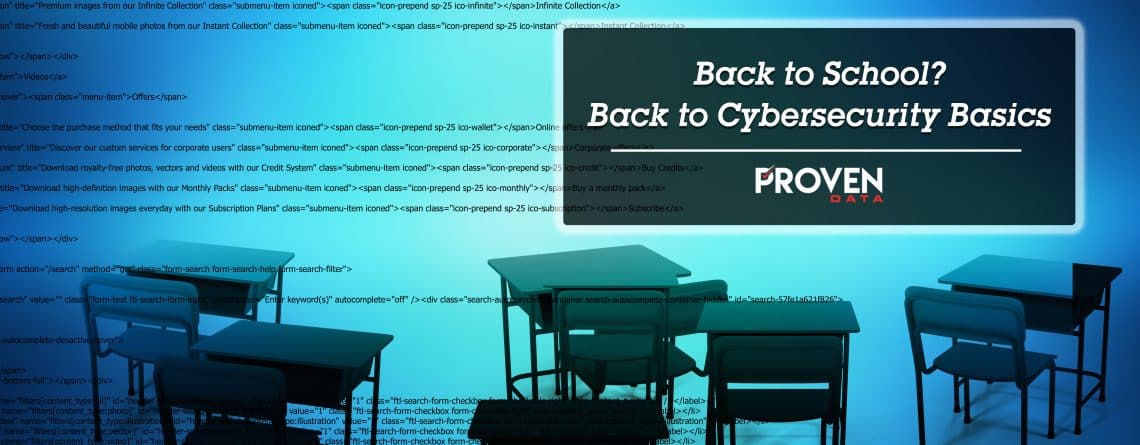Every year as Labor Day moves near, students, teachers & faculty alike prepare to return to the daily routine of school sessions around the country. Educational institutions of all sizes continue to use technology and online resources to help provide more learning materials and modernize classroom functions. Now more than ever, students & teachers are more connected to the digitized world, and as such, they must ensure better cyber security basics and proactively keep their data & information safe. With more schools becoming targets for cyber crime, such as ransomware, everyone plays an important role in promoting cyber security basics.
Schools being targeted by cyber crime
The upcoming school season will also be an excellent opportunity to communicate more awareness around the importance of cybersecurity and creating a protected connected environment. As classrooms continue to use more technology (such as connected devices and Internet of Things) this ultimately can serve as more ways that cyber criminals can get into the network and create havoc.
It’s also unfortunate that schools are suffering from IT staff shortages and often do not invest in the necessary cyber security products and services as they prioritize reducing some of the risks associated with all this new technology. The school environment has many computer security vulnerabilities for both students and staff alike, and a collective approach to applying the cyber security basics is the best way to stay protected!

Cyber security basics to follow during school season
Students, staff, and faculty should follow some cyber security basics to ensure their school and personal data is secured throughout the year:
Update, update… update!
Software patch updates are significant to developing an improved security framework that can help everyone stay resilient to the most modern cyber threats. When software and manufacturers become aware of major security flaws, they release these updates to fix vulnerabilities (this includes all devices and their operating systems).
Students & staff shouldn’t feel bothered by these notifications and take time each week to make sure their software is up to date. Enabling automatic updates can assure that you’ll be reminded every time there is a new revision to the current software, and you definitely can take advantage of this.
Use secured Wi-Fi networks
Students are notorious for traveling around school campus and searching for the nearest & fastest WiFi network to connect to. More often than not, users are unaware of what exact network they are connecting to, and just desire the fastest and most reliable connection possible. As a result, these hotspots can be lacking security protocol (such as WPA2 connection) and be configured to steal credentials and un-encrypted information over the network. It’s wise to do some research on the authentic WiFi network of the school or university by analyzing legitimate printed documentation or inquiring with the IT team.
We also recommend taking a look at the usage policy that the school uses which may not guarantee the anonymity of the information & documents you are uploading to the school network. It’s quite possible that a university or other higher-educational entity has strict guidelines on usage policy and the data & information they now own through their management of the network. This is especially important for ensuring your personal information and data privacy freedoms stay intact.
Enable two-factor authentication
The simplicity of enabling Two-Factor Authentication (2FA) can have a significant impact on improving the overall security of accessing your accounts. Enabling this on the official email associated with your school or university is the best way to start. If you’re the IT leaders of a school district, consider making this a mandated policy for all students & staff so there are fewer chances of unauthorized users gaining entry and creating devious attacks by using social engineering.
Backup important data regularly
One of the basics of cyber security is to backup your data. Data backup procedures have long been viewed as burdensome, and we must make an end to this culture negative attitude… All key stakeholders in education (staff, students, and faculty) need to back up their data for a variety of reasons. First, if your data ever becomes compromised or encrypted, you’ll have a log with a version of all the past files that are accessible. Second, having assignments, papers, and other data & files all backed up will protect them from being accidentally deleted or misplaced, which will, in turn, help you keep on top of all your schoolwork. Lastly, it’s wise to keep a proven data record of all those long essays and research papers you’ve written throughout the years.
These documents can be priceless as you continue your personal career (and throughout college and master’s programs, if you choose the path of higher education), to develop your own knowledge base! Be sure your backup copies are not connected at all times. You want to be sure you back up when not connected to the internet, and disconnect your backup upon completion. This ensures if you do have an issue, your backup is not connected during a cyber incident.
Don’t share your Netflix account around campus
Although it might seem so innocent (and, above all, an affectionate gesture) we recommend keeping that Netflix username and password to yourself and the intended account ownership. Not only do an overwhelming majority of people use the same passwords for multiple accounts, but these passwords have also been compromised in many well-known data breaches in the past. If your friend uses your password to log in to Netflix on an unsecured network (completely unbeknownst to you), it further increases the possibilities that your credentials can be leaked onto the web!
Netflix and Chill?… Let’s make it… Netflix and keep your password safe.
If we can encourage all of the educational community to continue staying curious into data security, it will set a foundation for taking these fundamentals and using them throughout their careers. The school is a great place to start with cybersecurity, as everyone in this environment is learning and should push new cyber culture into the seams of education.
Using the cyber security basics and data protection can become the groundwork for living a positive, digitally protected life that will carry with students throughout their lifetime!
Good luck to all students & staff heading back to schools this fall season!







